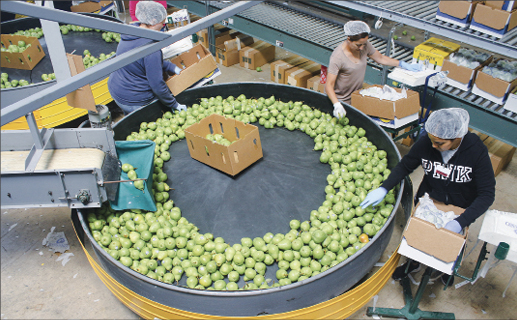Jul 23, 2022California pear market ‘is on fire’
After years of removing their trees due to shrinking markets, California pear growers won’t have much of a problem finding buyers for their fruit this year.
With harvest ramping up in the Sacramento River district, which produces the bulk of the state’s pears, growers such as Alex Wilson are upbeat. “Right now, the fresh market is on fire,” he said. “It’s an exciting time to be a pear grower.”
Wilson’s family operates Rivermaid Trading Co., the state’s largest pear supplier. The company grows its own pears in the delta and handles fruit from the state’s three main growing regions: Sacramento, Lake and Mendocino counties.
The focus is on Bartlett, the most widely grown pear that’s used in canning and for fresh-fruit eating. It accounts for nearly 90% of the state pear crop. Last year, 63% of California’s total pear volume went to canning and other processing, according to the California Pear Advisory Board. Chris Zanobini, the board’s executive director, described demand for processing pears as high.
“The cannery price definitely sets the bar for where fresh market returns have to come in at,” he said.
Even though overall production is expected to be about the same as last year—an estimated 117,692 tons this year compared to 121,106 tons in 2021—Zanobini noted the state has fewer acres.
The reduced plantings have led to demand exceeding supply, Wilson said, with packinghouses competing with canneries for pears. He said early-season fresh market prices could top what canneries are offering by $200 a ton.
“In general, pear growers are going to be very impressed with the returns that the fresh market brings to them,” Wilson added.
That wasn’t always the case. Just four years ago, Seneca Foods announced closure of its Modesto cannery ahead of the 2018 pear season, and growers who lost their contracts were scrambling, with some deciding to rip out orchards. The year Seneca shuttered, 66,720 tons of pears went to canning, compared to 103,743 tons in 2017, according to the pear board.
Statewide, two pear canneries remain: Walnut Creek-based Del Monte Foods and Pacific Coast Producers, based in Lodi. In addition to Rivermaid, there are three other pear packers: Scully Packing Co. in Lake County, and Greene & Hemly and Stillwater Orchards, both based in Courtland.
State pear acreage stood at 9,400 in 2021, down from 9,900 in 2020 and 10,000 in 2019, according to the U.S. Department of Agriculture. Growers say they believe acreage is much lower this year.
With canneries and packers vying for pears, Wilson said growers are weighing options on where to send fruit to “keep both relationships happy.” While they don’t want to miss out on the “phenomenal pricing in the fresh market,” he said, they see multi-year cannery contracts as a guaranteed home for their crop in years when the fresh market is oversupplied.
Kyle Persky, who handles sales for Rivermaid, said the fresh Bartlett market starts “fairly high.” Then the price drops every week and settles just as the Pacific Northwest begins shipping its pears.
“This year, I think we’ll see a more stable, consistent Bartlett market,” he said, “and a lot of that is driven by processing demand. It kind of creates the price floor.”
What’s more, there’s less carryover fruit from South America, Persky said, especially in West Coast markets, creating “a fairly open pipeline.” The Pacific Northwest crop is also expected to be down a bit and later than usual, which will give California a longer window to market its pears, he said.
Robert Arceo, who manages farming for Rivermaid, said the company’s own orchards saw a lighter crop this year, and as such, the fruit is bigger. Still, he said he’s waiting for the fruit to get even larger, “because size is everything.” That meant applying fertilizer earlier and more water, which is needed to size the fruit, he said.
Meanwhile, orchards in Mendocino and Lake counties had “an exceptional bloom with good weather,” said Scott Fraser, sales manager for Scully Packing. He said harvest of Bartletts is expected to begin the week of Aug. 1, with volumes similar to last year. He described this year’s crop as “excellent quality with a normal distribution of sizing.”
Mendocino County grower Chris Ruddick said he will likely begin harvest of Starkcrimson, an early red pear, this week or next. His trees suffered from heat and a lack of rain during the past two years, he said, with this year’s crop “somewhat lighter than normal.” After taking “a beating on income” last year due to smaller fruit, Ruddick said he’s in no hurry to start picking, as he wants larger sizes. With a smaller crop, “I think we can make up our tonnage difference a little bit that way,” he added.
All his Bartletts are destined for the cannery, while his Starkcrimson, Seckel and Bosc pears go to the packinghouse, where size becomes critical, he said.
Hurt by drought and smaller fruit during the past two years, Ruddick said, the region lost “a lot of acreage.” Now the market is bullish on pears, he said, with packers and canners “looking around to see what they’ve got and trying to lock up what they can.” Optimistic about the business, he said he’s planning to plant a new pear orchard to replace one he tore out several years ago.
“It’s nice to have somebody say we want (pears) instead of saying maybe,” he said.
– Ching Lee, California Farm Bureau Federation















